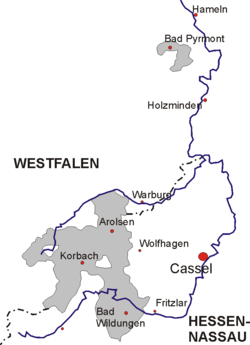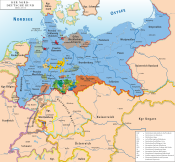Principality of Waldeck and Pyrmont
This article needs additional citations for verification. (November 2016) |
Principality of Waldeck and Pyrmont Fürstentum Waldeck und Pyrmont | |||||||||
|---|---|---|---|---|---|---|---|---|---|
| 1180–1918 | |||||||||
  Top: Flag
(before 1830) Bottom: Flag (after 1830)  Coat of arms
| |||||||||
| Anthem: "Mein Waldeck" | |||||||||
 Waldeck (red) within the German Empire. The small northern territory is Pyrmont while the southern lands are Waldeck. | |||||||||
 Map of Waldeck, showing the border between Westphalia and Hesse-Nassau | |||||||||
| Status | State of the Holy Roman Empire State of the Confederation of the Rhine State of the German Confederation State of the North German Confederation State of the German Empire | ||||||||
| Capital | Waldeck (to 1655) Arolsen (from 1655) 51°22′N 9°1′E / 51.367°N 9.017°ECoordinates: 51°22′N 9°1′E / 51.367°N 9.017°E | ||||||||
| Common languages | German | ||||||||
| Religion | United Protestant: Evangelical State Church of Waldeck and Pyrmont | ||||||||
| Government | Principality | ||||||||
| Historical era | Middle Ages | ||||||||
• Established as a County | 1180 | ||||||||
• Became Reichsgraf (immediate count) | 1349 | ||||||||
• Succeeded to Pyrmont | 1625 | ||||||||
• Raised to Imp. Principality | January 1712 | ||||||||
• Autonomous within Prussia | 1868 | ||||||||
| 1918 | |||||||||
• Subsumed into Prussia | 1929 | ||||||||
| Area | |||||||||
| 1905 | 1,121 km2 (433 sq mi) | ||||||||
| Population | |||||||||
• 1905 | 59,135 | ||||||||
| |||||||||
The County of Waldeck (later the Principality of Waldeck and Principality of Waldeck and Pyrmont) was a state of the Holy Roman Empire and its successors from the late 12th century until 1929. In 1349 the county gained Imperial immediacy and in 1712 was raised to the rank of Principality. After the dissolution of the Holy Roman Empire in 1806 it was a constituent state of its successors: the Confederation of the Rhine, the German Confederation, the North German Confederation, the German Empire and, until 1929, the Weimar Republic. It comprised territories in present-day Hesse and Lower Saxony (Germany).
History[]


Waldeck was a county within the Holy Roman Empire from about 1200. The ruling counts were a branch of the Counts of Schwalenberg (at Schwalenberg Castle). Waldeck Castle, overlooking the Eder river and first mentioned in 1120, was inherited by count Widekind I of Schwalenberg and his son Volkwin, from the counts of Itter and the counts of Ziegenhain, when they married wives of these families. Waldeck remained the main residence of the county until 1655.
Its counts included Adolf II of Waldeck from 1270 to 1276. In 1655, the residence was shifted from Waldeck to Arolsen. In 1625, the small county of Pyrmont became part of the county through inheritance, as it had also been ruled by a branch of the counts of Schwalenberg.
In January 1712, the count of Waldeck and Pyrmont was elevated to prince by Charles VI, Holy Roman Emperor. For a brief period, 1805 to 1812, Pyrmont was a separate principality as a result of inheritance and partition after the death of the previous prince, but the two parts were united again in 1812. The independence of the principality was confirmed in 1815 by the Congress of Vienna, and Waldeck and Pyrmont became a member of the German Confederation. From 1868 onward, the principality was administered by Prussia, but retained its legislative sovereignty. Prussian administration served to reduce administrative costs for the small state and was based on a ten-year contract that was repeatedly renewed for the duration of its existence. In 1871, the principality became a constituent state of the new German Empire. At the end of World War I, during the German Revolution that resulted in the fall of all the German monarchies, the prince abdicated and the principality became the Free State of Waldeck-Pyrmont within the Weimar Republic.
The princely house of Waldeck and Pyrmont is closely related to the royal family of the Netherlands. The last ruling prince, Frederick, was the brother of Queen Consort Emma of the Netherlands.
In 1905, Waldeck and Pyrmont had an area of 1121 km2 and a population of 59,000.
Gallery of castles[]

Castle Waldeck, Hesse
Friedrichstein Castle at Bad Wildungen
Rulers[]
- 1712–1728: Friedrich Anton Ulrich (1676-1728); elevated 1712 to hereditary prince by Emperor Charles VI
- 1728–1763: Karl August (1704-1763)
- 1763–1812: Friedrich Karl August (1743-1812)
- 1812–1813: George I (1747-1813)
- 1813–1845: George II (1789-1845)
- 1845–1893: George Victor (1831-1893)
- 1813–1845: George II (1789-1845)
- 1728–1763: Karl August (1704-1763)
Military[]
Waldeck had raised a battalion of infantry in 1681 but for much of the subsequent history leading up to the Napoleonic Wars, Waldeckers generally served as what is commonly described as 'mercenaries', but was actually 'auxiliaries' hired out by the rulers of Waldeck for foreign service. Such was the demand that the single battalion became two in 1740 (the 1st Regiment), three battalions in 1744, four in 1767 (forming a 2nd Regiment). Most notably the foreign service was with the Dutch (the 1st and 2nd Regiments) and English (after an agreement was signed with the English in 1776 to supply troops for the American War of Independence, the 3rd Waldeck Regiment, of a single battalion, was raised). The 3rd Waldeck Regiment thus served in America, where they were known under the 'umbrella term' used during that conflict for all Germans—'Hessians'. The regiment, which was made up of 4 'Battalion companies', a 'Grenadier' company, staff and a detachment of artillery, was captured by French and Spanish troops supporting the Americans and only a small number returned to Germany, where some formed part of a newly raised 5th Battalion (1784).
By the time of Napoleon's conquest of Germany, the Waldeck Regiments in Dutch service had been dissolved when, as the Batavian Republic, Holland was made into a kingdom ruled by Napoleon's brother Louis. Reduced to battalion strength, they now formed the 3rd battalions of the 1st and 2nd Infantry Regiments of the Kingdom of Holland. The 5th Battalion was disbanded, and Waldeck was now also obliged to provide two companies to the II Battalion, 6th German Confederation (i.e., Confederation of the Rhine) Regiment (along with two companies from Reuß) in the service of the French Empire. As with all French infantry, they were referred to as 'Fusiliers'. They served mainly in the Peninsula War against the Duke of Wellington. In 1812, the 6th Confederation Regiment was re-formed, with three companies from Waldeck and one from Reuß again forming the II Battalion. By the time of the downfall of the French Empire in 1814 the battalions in Dutch service had disappeared, but Waldeck now supplied three Infantry and one Jäger Companies to the newly formed German Confederation.

By 1866, the Waldeck contingent was styled Fürstlisches Waldecksches Füselier-Bataillon, and in the Austro-Prussian War of that year Waldeck (already in a military convention with Prussia from 1862) allied with the Prussians; however the Battalion saw no action. Joining the North German Confederation after 1867, under Prussian leadership, the Waldeck Fusilier Battalion became the III (Fusilier) Battalion of the Prussian Infantry Regiment von Wittich (3rd Electoral Hessian) No. 83, and as such it remained until 1918. The position of regimental 'Chef' (an honorary title) was held by the Prince of Waldeck and Pyrmont.
Unlike Hesse-Darmstadt, Hesse-Kassel (or Hesse-Cassel) retained no distinctions to differentiate them from the Prussian. The Waldeckers however, were permitted the distinction of carrying the Cockade of Waldeck on the Pickelhaube. The Waldeck battalion was garrisoned, at various times, at Arolsen/Mengeringhausen/, Bad Wildungen, Bad Pyrmont and Warburg.
The regiment saw action in the Franco-Prussian War of 1870 (where it acquired the nickname Das Eiserne Regiment), and during the First World War—as part of the 22nd Division—fought mainly on the Eastern Front.
See also[]
References[]
External links[]
| Wikisource has the text of the 1911 Encyclopædia Britannica article "Waldeck-Pyrmont". |
| Wikisource has the text of the 1913 Catholic Encyclopedia article Principality of Waldeck. |
 Media related to Waldeck (state) at Wikimedia Commons
Media related to Waldeck (state) at Wikimedia Commons- Principality of Waldeck (in German)
- Canon law of the regnancy Waldeck, 1556
- Decorations of the Principality of Waldeck
- National anthem and flags
- Principality of Waldeck and Pyrmont
- States and territories disestablished in 1918
- States and territories established in 1180
- Former states and territories of Lower Saxony
- States of the German Empire
- States of the German Confederation
- States of the North German Confederation
- States of the Confederation of the Rhine
- Principalities of the Holy Roman Empire
- Waldeck (state)
- 1180s establishments in the Holy Roman Empire
- 1180 establishments in Europe
- 1918 disestablishments in Germany












